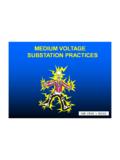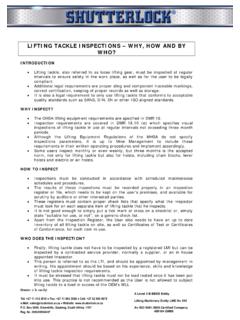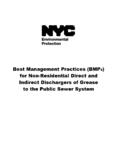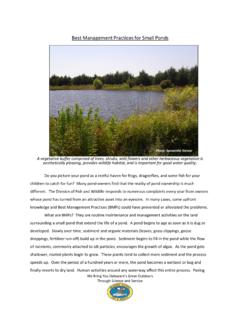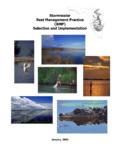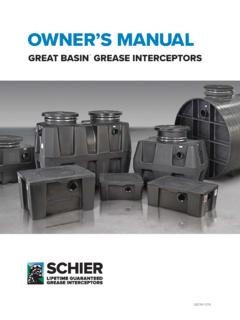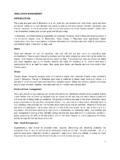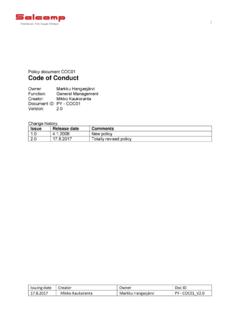Transcription of Best Practices of Contamination Control - SACEA
1 Contamination Control best Practices In order to satisfy customer demands, s are forced to design more sophisticated systems with higher pressures and tighter clearances. Machine systems are a lot more sensitive to contaminants today than they were a number of years ago. As a result, fluid Contamination threatens reliability throughout the life cycle of today's machines and engines, making Contamination Control essential to extracting the full value built into products. The purpose of this document is to illustrate various best Practices for the implementation of a successful Contamination Control program relating to earthmoving equipment. A proper Contamination Control program provides a significant opportunity for cost saving, and insures that companies are on par with world-class best Practices . By Robert Garvie (Using best Practices as introduced by Caterpillar) Barloworld Equipment Electron Avenue Extension Isando 2 Benefits of Contamination Control (CC) The benefits of CC include: Longer component life Reduced re-work Extended oil drain intervals Increased productivity Professional image Lower operating costs Reduced hazardous waste generation A positive culture change Implementation of Contamination Control (CC) CC Champion The best approach to implementing CC is to introduce a documented, comprehensive program of best Practices , procedures and standards.
2 This program should be continually evaluated and managed. Ideally, this function should be assigned to a single person, a CC champion . Ideal characteristics of a CC champion: Has a basic knowledge of the complete operation and processes Good communication skills A positive attitude toward CC and an understanding of the necessity thereof Computer literate A good motivator The accountability of individual areas and tasks should not all be delegated to the CC champion, but should be delegated to suitable operations personnel. Cleanliness Levels Since the main objective of CC in our context is clean fluids, cleanliness requirements (using ISO codes) should be established for each type of fluid used. The monitoring and maintaining of these cleanliness levels are the most critical aspect of CC. Cleanliness requirements should be obtainable from the equipment manufacturer.
3 Even though these requirements provide the cleanliness targets, it must be remembered that cleaner is better . Fluid cleanliness is monitored through particle counting. Various particle counters are available on the market. Kidney looping can be used for cleaning a fluid, which is out of spec. Kidney looping is simply passing the fluid through filters, which are external to the normal system. Various types of filter carts are available for this. Contamination Control (CC) best Practices Wash Facility All machines must be washed before entering the shop The reason is obvious: to keep the shop clean, don t allow dirty machines to enter. The wash bay should be equipped with high volume wash equipment Ideally, mounted water cannons should be used. These are typically in the range of 414kPa to 552kPa with a flow rate of 303 l/m to 378 l/m per cannon.
4 For larger machines the cannons should be mounted higher for a better angle. These cannons should be supplemented by a hand 3 held fire hose for cleaning the out-of-reach areas. Having this type of equipment minimizes washing time and promotes an effective wash. The path from the wash bay to the workshop should be kept clean The path should be constructed of concrete, crushed stone, dust-a-side, or similar material. Periodically cleaning this path clean will minimize dirt being tracked into the shop. Use hot water and soap in the wash bay Cleaning is more effective when hot water and soap are used for greasy areas. A separate soap sprayer can be used. Shop Attributes Ensure that workshops have doors and that they re used during dusty/rainy conditions Seal workshop floors Sealed floors are easier to clean and oil doesn t penetrate into the concrete easily.
5 Mark walkways and safety/storage areas Good organization and housekeeping promote cleanliness. Use component stands for frequently-worked-on components Using the proper stand enhances both the safety of the job and the cleaning under the component. Use wooden blocks for other components It s impractical to have a stand for each type of component. For not-so-regular components use wooden blocks, instead of placing the component on the floor, or instead of using pallets. Cover assembly benches with plastic or rubber matting to protect parts Use filters and water separators on air lines Air blown on parts should be clean and dry. Install filters on solvent stands The solvent used for cleaning parts should also be clean! For best results install a 4 micron final filter, a 15 or 25 micron bag filter on the drain and a diatomaceous earth media filter in the reservoir.
6 All three filters assist in cleaning the fluid. Also, the bag filter makes the final (more expensive) filter last longer, and the earth media filter makes the solvent last longer, by removing the oil from the solvent. Solvent cleanliness should also be monitored through particle counting. 4 Use final filters on oil supply lines Ensure that filters are installed on shop supply lines. The correct filtration design should be used to ensure that the oil meets the determined cleanliness level. Remove grinding and cutting operations from assembly areas These operations should be done in dirtier environments, such as the welding shop. Shop Practices Use caps, plugs and plastic wrap for protecting components Caps and plugs provide better, more visually attractive protection for openings than do masking tape and plastic.
7 For irregular size openings use aluminium tape. Plastic wrap should be available for protecting components/parts. Use rust proofing on critical components and wrap them individually Rust is often overlooked as a contaminant. Critical components refers to items such as gears, camshafts, bearings, etc. Cover all components waiting for assembly and use rust proofing as necessary This refers to not-so-critical items such as housings, hardware, covers, etc. Protection is easily achieved by putting items in wire baskets and wrapping/covering the entire basket with plastic. Keep new parts and components in their original packaging until they re ready for assembly Use a fluid recovery cart for reusing oil A lot of money can be saved by reusing oil, which has not reached the end of its life yet. A recovery cart can be used to filter the oil back to the determined cleanliness spec, while a repair is being done.
8 Implement a procedure for cleanly refilling lubricant containers Using a proper procedure for cleaning and refilling oil cans, grease guns, etc. with clean lubricants reduces the chance of contaminants being introduced through these. Shop Housekeeping Use a vacuum and absorbent pads for cleaning up oil spills Don t use sawdust (or similar material), since this also introduces contaminants to the workshop. The best method for cleaning oil spills is to use a vacuum and/or absorbent pads, followed by a hot water mop. Oil spills should be cleaned up immediately. Label and paint waste containers 5 Hydraulic Hose Rebuilding Install an extraction fan and dust collector on the hose saw This reduces the debris in the hose assembly area. Store hoses with ends capped Protect couplings Couplings can be kept clean by putting them in plastic bags, sealed containers or by closing both ends with plastic plugs.
9 Clean hoses properly before and after assembly Use a hose gun for proper cleaning. Before assembly, shoot two clean projectiles through the cut-off hose (one in each direction). After the hose is assembled, shoot another two projectiles through the hose assembly (one in each direction). If the last projectile is still dirty, continue the process until the projectiles appear clean. Parts Storage Keep filter boxes closed Store o-rings in plastic bags in enclosed drawers Implement a program for periodic cleaning of shelves, etc. Dispatch parts in plastic bags Reman Parts Returns Plug all openings and use rust proofing where applicable Use shipping stands for large components and shrink wrap these components 6 Oil Storage and Handling Filter fluids entering and exiting storage tanks Filtering fluids before they enter the tanks ensures that the tanks remain clean and don t become a source of Contamination .
10 Use 2 or 4 micron silica gel breathers Do particle counting periodically and keep PM records If fluid cleanliness is measured, then it can be managed. Whenever the cleanliness level drops out of spec, corrective action should be taken. Protect lube truck hoses and nozzles The hoses and nozzles should be in closed, regularly-cleaned compartments. Nozzles should be wiped with a lint-free rag before use. Use covers on oil drums Using covers not only prevents water and dirt from settling on the drums, but also allows drums to be cleanly stored in the upright position. Fueling With the tight clearances in modern fuel systems, these systems are perhaps the most sensitive to contaminants. Use fast fueling equipment 7 Use final filters on fuel lines This refers to the fuel island as well as the fuel truck.
